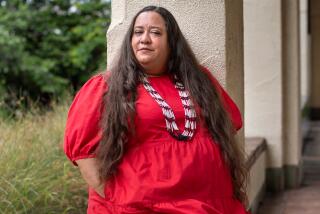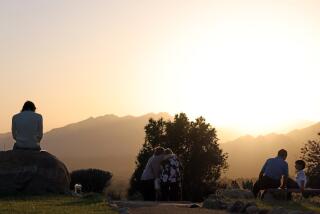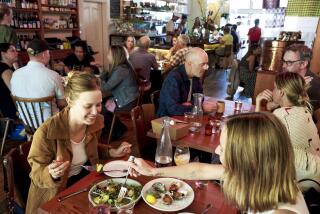Chumash Leader Dies; Aided Cultural Revival
- Share via
Vincent (Beaver) Tumamait of Ojai, an elder and spiritual leader of the Chumash nation who helped create a renaissance of his people’s culture, died Tuesday in an Ojai hospital. He was 73.
Tumamait worked 30 years as an oil field roustabout, trucker and mechanic with Shell Oil Co. in Ventura before retiring in 1983. A tool he created as a mechanic is still used by oil field workers.
But Tumamait was best known for his contributions to Chumash Indian culture, which he helped preserve by sharing stories, dances and cultural knowledge at schools and public gatherings.
He was a frequent lecturer at the Santa Barbara Museum of Natural History and the Ventura County Museum of History and Art, and was the subject of “Voices of the Planet,” a Public Broadcasting System documentary.
Tumamait was most recently honored in July, when he served as the grand marshal in the Ojai Valley Fourth of July Parade.
“His death is a big loss for his family and for all of the Indian nation,” said Tony Romero, a Chumash elder who lives on the Chumash Reservation in Santa Barbara County.
“He was a wonderful philosopher of the traditional Chumash way,” Romero said. “I consider myself fortunate to have known him well.”
When the Spanish arrived in the area 200 years ago, as many as 20,000 Chumash inhabited the coast between Malibu and San Luis Obispo. Because of new diseases that the Spaniards brought with them, fewer than 1,000 Chumash survived by the mid-1800s. Today, an estimated 4,000 residents of Chumash descent live in the region. No full-blooded Chumash are known to survive.
Tumamait was born July 19, 1919, in Ventura, and graduated from Ventura High School and Ventura Junior College. His father, Cecilio Tumamait, was a full-blooded Chumash, and his mother, Maria, was half-Chumash.
Tumamait--Chumash for “seat of the chief”--is the only Chumash surname known to remain in the area, said Kathleen Conti, the director of Chumash art at the Santa Barbara Museum of Natural History.
In a genealogical study by John Johnson, curator of anthropology at the Santa Barbara museum, Tumamait’s family was traced back eight generations. “His ancestors literally came from all over the Chumash area, from Huasna--the old village in San Luis Obispo--to Mishopshno, the Chumash village where Carpinteria is located,” Conti said.
Tumamait took only a slight interest in his ancestry before his retirement. After he was asked to participate in a cultural program for the city of Ventura in 1984, he began a process of self-discovery that continued until his death.
“It started to build up in me just what our culture was,” Tumamait said in a 1990 interview. “The Indian people I meet teach me. I’m a learner.”
Others remember Tumamait as a wise paha , or spiritual leader, and as a generous teacher who shared his knowledge of traditional ways with Chumash and non-Indians alike.
“He gave us back our respect,” said Julie Tumamait, one of Tumamait’s seven children. “The Chumash grew up with a stigma of prejudice. When he presented his culture in the best way it came to him--through storytelling--a lot of our people came out of the closet and claimed their Chumash heritage.”
Tumamait is survived by his wife, Lucy Barrios Tumamait of Ojai; two sisters, Bertha Blanco and Margaret Duarte, both of Ventura; three sons, Vincent James Jr. of Ventura, Leo Albert of Santa Barbara and Patrick Gilbert of Ojai; four daughters, Rachel Duarte, Rose Marie Moore, Gloria Torres and Julie Tumamait, all of Ojai; 17 grandchildren, and seven great-grandchildren.
A rosary will be recited at 7 p.m. Thursday at St. Thomas Aquinas Church in Ojai and a funeral Mass will be said at 10 a.m. Friday at the same site. Funeral arrangements are under the direction of the Joseph P. Reardon Funeral Chapel in Ventura.
More to Read
Sign up for Essential California
The most important California stories and recommendations in your inbox every morning.
You may occasionally receive promotional content from the Los Angeles Times.













